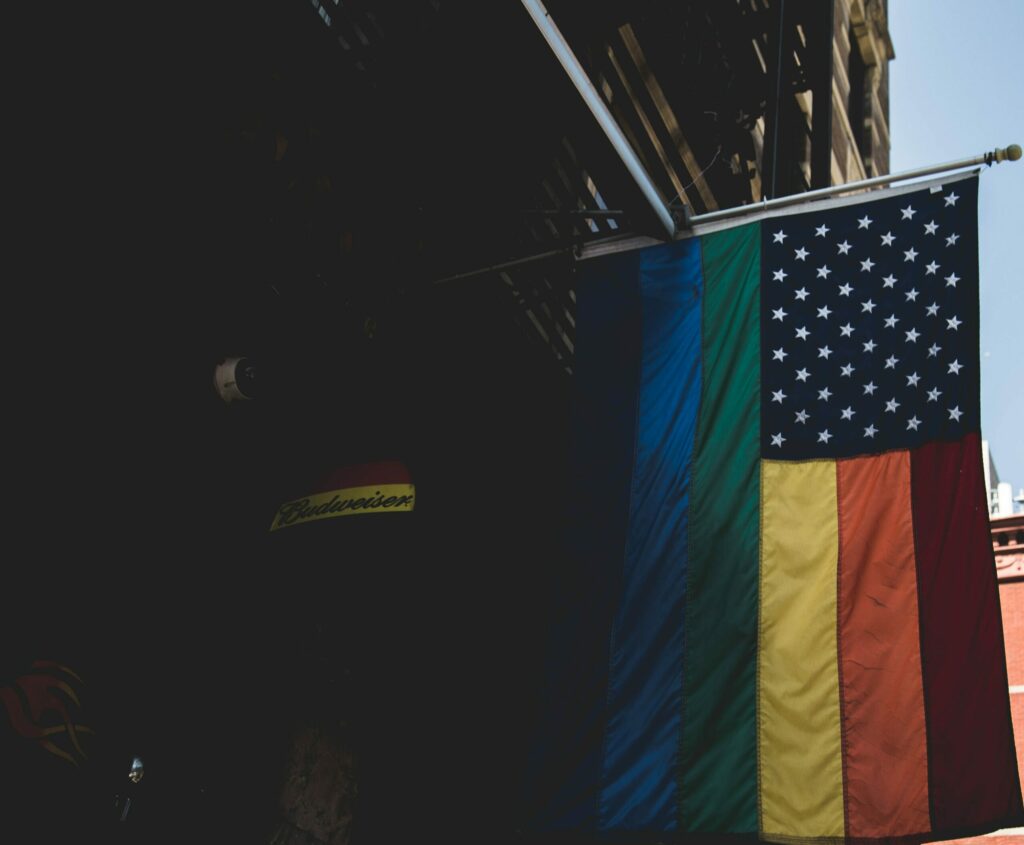It’s 2023. Is rainbow capitalism dead yet? The answer is: not quite.
Rainbow capitalism has been a steady growing force under late stage capitalism ever since it’s become sort of uncool to hate queer people. Remind me when that was exactly? Not to say that we haven’t made strides in the previous century, in fact the LGBTQ+ movement had progressed at a rapid pace since the Stonewall riots over 50 years ago.
One in five Gen Z adults identifies as LGBTQ+ and more Americans than ever support LGBTQ+ people from marriage to nondiscrimination protections. And while the evangelical church and Rob Desantis might think hating LGBTQ+ community still gets you popularity points, there is proof that support is rapidly growing for queer and transgender people in many avenues of American life—including consumerism.
While seeing gay couples in a Kay Jewelers commercial or picking out a rainbow bag of Skittles from your local 7-Eleven might seem like a good thing, is it enough? We all know that rainbows are cute, but slapping a pride flag on your product (and profiting off queerness) isn’t quite the same thing as supporting the fight for queer and transgender liberation. But what exactly is rainbow capitalism, and how can companies and allies actually show up for the LGBTQ community? Let me break it down for you.
Source: Twitter
What does rainbow capitalism mean?
For those of you who don’t know, the term ‘rainbow capitalism’ (otherwise known as rainbow washing, pink washing, or pink capitalism) is when companies appropriate and profit off of the LGBTQ+ community without actually supporting queer and trans people. Rainbow capitalism has become a popular marketing strategy as the LGBTQ+ community has gained social acceptance and purchasing power (a.k.a pink money) in the 21st century.
But companies showing their support for queer and trans people is a good thing, right? Not when the purpose is to commodify, commercialize, and profit off the LGBTQ+ community without internal policies or external practices that actually improve the lives of queer people. Rainbow capitalism points to the empty and tokenizing displays of LGBTQ+ allyship from major corporations and companies.
What does rainbow washing look like?
Although rainbow washing can happen year-round, it is especially rampant in June during the Pride Month cycle. This is typically the time of the year where brands go a bit off the rails trying to create the most relevant, unhinged, and (let’s just say) unique ad campaigns targeted at the LGBTQ+ population. Don’t believe me? Who could forget IKEA’s bisexual love seat or Postmates’ cringeworthy Bottom friendly Menu.
Source: Instagram
Rainbow washing can be as simple as your favorite company adopting a rainbow version of its logo on June 1st (only to just revert back to the original 30 days later). Perhaps you’ve walked into a Target in years past and seen their annual Pride section with rainbow-colored mugs, waters, water bottles, and other gay paraphernalia (more on this to come). Or maybe you’ve noticed that there is one month in particular when you see a spike in queer people in marketing campaigns and advertisements. Then you wait for the return of normal, boring, heterosexual programming for the other 11 months of a calendar year.
Regardless of the different tactics that companies use, the problem with rainbow capitalism isn’t simply the visual display of support for LGBTQ+ people (although for the earth tone queers in the room, some of the rainbow merch can be a tad tacky, no?). The real problem is the lack of authenticity behind the messaging.
Remember that one time when AT&T launched a #TURNUPTHELOVE campaign in 2021 to support LGBTQ+ youth while having donated at least $1,052,000 to anti-LGBTQ politicians since that same year? Companies who act like they support queer people with a rainbow when there is money to be made will be the same ones to turn around and donate to the very same political campaigns and bills that strip away LGBTQ+ civil liberties. Somebody come collect corporate America, her hypocrisy is showing.
But surely not all efforts to promote diversity and inclusion of LGBTQ+ people in marketing and advertising are that bad, right? What about representation? Isn’t the tokenism that comes from pink washing better than nothing at all? I’ve spent hours with my partner debating the very same questions in our living room. Here are some of the pros and the cons of rainbow capitalism, and what we can actually do about it.
Source: Twitter
Pros of rainbow capitalism
One of the biggest arguments for rainbow washing is the power of representation. When brands uplift and showcase real queer and trans experiences, they have the ability to reach millions of people across the world.
As a kid growing up in mid-America in the 90s, queer representation was few and far between. I don’t know what I would have done if I had turned on the TV and seen someone who looked like me. It makes me emotional to think about how much easier my journey to finding myself would have been if I had any representation of queer or trans existence outside of talk shows like Ricki Lake and Jerry Springer.
One of the pros of rainbow capitalism is the fact that young queer and trans kids can have access to positive and affirming messages about their identities. Rainbow washing in marketing and advertising normalizes and celebrates the existence of LGBTQ+ people and relationships, which can play a major role in promoting social acceptance.
Cons of rainbow capitalism
Now comes time for the cons. You’re going to want to sit down for this one. Besides tokenizing LGBTQ+ people, creating harmful stereotypes of queer experiences, and making empty promises to support the queer community while quite literally fueling the legislative efforts that disenfranchise our rights, there is a darker side to rainbow capitalism that has started to rear its head in recent years.
The rise of trans panic in recent years has caused brands to have to re-evaluate the risk/reward calculations of visibly (and vocally) supporting the LGBTQ+ community. I could spend the rest of my days around a campfire telling disastrous accounts of rainbow washing gone wrong. The most recent of which was Target’s rescinding of their Pride collection this summer in stores across the U.S. due to anti-LGBT right-wing backlash. In June 2023, angry, homophobic, and transphobic customers took to the stores with their video phones in hand to deface Target’s Pride displays, threaten store employees, and even call in anonymous bomb threats.
Target had been a leader in LGBTQ allyship in previous years by working with and featuring queer and trans artists and designers in their annual Pride collection. However, this year they decided to cave under the pressure of anti-trans sentiments and remove “controversial items … at the center of confrontational behavior.” Some of the “controversial” items removed included t-shirts and cards made by queer and trans couple Ash and Chess reading “So Happy You’re Queer,” “Trans People Will Always Exist,” and “Support Trans Futures.”
Source: Instagram
Target now joins the ranks of many seemingly liberal and progressive companies that revoke their support for the LGBTQ+ community under anti-trans pressure. Right-wing supporters have begun to target (pun intended) and “send a message” to “woke” companies who stand with queer and trans people.
This year Starbucks instituted a nationwide ban on Pride-themed merchandise in its stores. Anheuser-Busch (the company that owns Budweiser) created a sponsored Tik Tok post with trans influencer and all-American girl Dylan Mulvaney. The company quickly clarified their position by informing people in a statement that they “never intended to be part of a discussion that divides people. We are in the business of bringing people together over beer.”
Boycotting can be an effective strategy, but it’s hard to work out whether people are boycotting companies for supporting LGBTQ+ people or for abandoning us. While Dylan Mulvaney received death threats, public harassment, and violent and humiliating online ridicule in the aftermath of the partnership, Budweiser never reached out to her.
Mulvaney added that hiring a trans person only to abandon them in the face of hate “is worse than not hiring a trans person at all. It gives customers permission to be as transphobic and hateful as they want,” she said. “And the hate doesn’t end with me; it has serious and grave consequences for the rest of our community.”
These examples of companies capitalizing off queer and trans people only to pull back their support for our community when confronted with the violence and bigotry that we face every day is the case and point of why rainbow capitalism doesn’t work. Be prepared for a backlash or don’t do it in the first place. Profiting off of marginalized people without actually doing anything to support our community in the face of hardship isn’t allyship, it’s cowardice.
Source: Twitter
Can LGBTQ+ corporate allyship ever be a good thing?
This is a difficult question to answer. There are over 500+ state and federal proposals seeking to criminalize LGBTQ+ existence from every facet of life in sports, schools, bathrooms, and our own workplaces. Placating domestic terrorists and anti-LGBT extremists only emboldens those who hold these beliefs. At this moment in which our community is under attack, we need stronger forms of solidarity than selling a rainbow bumper sticker.
While marketing efforts that include LGBTQ+ people can help set the tone for wider social acceptance, it can be challenging to tell whether or not a company’s display of support for LGBTQ+ people is genuine, especially if they risk losing sales by doing so. For most corporations, the ultimate priority will always be increasing value and maximizing profit. This means that if there is profit to be made from supporting queer and trans people, they will, but if there is a chance of losing money, they won’t.
We are proud to say that at HER, as a queer brand, we have an unflinching response to any anti-trans sentiments outside or inside the lesbian community. How a company responds to anti-trans-and-queer backlash will show you where their ethics really stand. And if a company won’t stand behind us on our worst day, they don’t get to celebrate with us on our best.
How can companies and allies support the queer community beyond rainbow capitalism?
While it’s true that there is no real ethical consumption under capitalism, the best way that you can support LGBTQ+ people under consumerism is to queer-owned brands. Bonus points if the brand has a history of standing up for trans rights as well. Beyond this, you can also donate to mutual aid funds, local grassroots organizations, or national crisis organizations such as Trans Lifetime or the Trevor Project.
Companies who want to support the LGBTQ+ authentically should have a look at their internal staff, systems, and hiring processes. Rather than outsource to create one-off queer marketing campaigns, hire queer and trans people internally in positions of leadership and direction.
Work directly with queer and trans influencers and talent. Find ways to incorporate diverse and vibrant queer experiences into your advertising strategies year-round. These strategies will not only make sure that you are standing on the right side of history, but that you look good while doing so. Not in a virtue-signaling way, but, like, the actual aesthetics. Because if there is one thing we, as gay people, are fundamentally good at—it’s making things cute.







